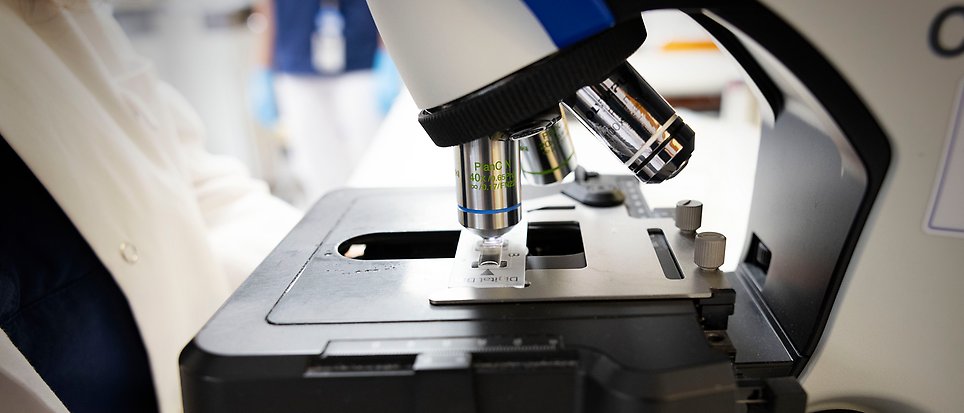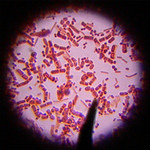Clinical Microbiology

The research group in Clinical Microbiology consists of independent groups working with important human pathogens, both bacteria such as Campylobacter and Chlamydia, and viruses. The goals are to understand how these pathogens are spread, how they cause disease, and to improve both detection and treatment as well as preventive measures.
Description of our research

Chlamydia trachomatis cervix sample. Photo: Björn Herrmann
Campylobacter
Campylobacter is the most important cause of bacterial gastroenteritis in the western world and causes significant economic and disease burden on society with more than 200 000 reported cases in the EU alone. Campylobacter is a major threat to public health with C. jejuni and C. coli being the major pathogens. Campylobacter is part of the gut flora in many domestic and wild animals and poultry products have often been shown to account for the majority of human infections. Despite the increasing knowledge on molecular epidemiology and ecology as well as the availability of whole genome sequences for Campylobacter, the bacterial pathogenicity mechanisms and human characteristics connected to disease are still poorly understood.
Detection and analysis of pathogens
Early and rapid detection of disease-causing pathogens is important for combatting infections caused by bacteria, virus or fungi. As the treatment has to be adopted to the type of pathogen we aim to develop diagnostic tests for viruses, bacteria and fungi. We also work to develop new bioinformatics methods.

Foto: U.Salvagnin, CC licence
Bacteria seen through a microscope.
Chlamydia infection
Chlamydia trachomatis is globally the most commonly reported sexually transmitted bacterium and gives rise to complications with infertility as final endpoint. The research group has developed a high-resolution typing system that enables epidemiological investigations of the spread in sexual networks and populations. Epidemiology and prevention of chlamydia from an international public health perspective is also a field of research interest.
Chlamydia psittaci is defined as a high risk pathogen causing fatal respiratory infections, but the spread from wild birds to humans is not well understood. C. psittaci infections in birds and their role for zoonotic disease are investigated. Detection and identification of other bacteria causing respiratory tract infections is an additional research topic.
Infection prevention and control
The WHO states that “No country, no health-care facility even within the most advanced and sophisticated health care systems can claim to be free of the problem of health-care associated infections (HAI)”. HAI are still the most common avoidable adverse event in Sweden and account for billions of extra costs, substantial morbidity and mortality among the hospitalised population and patients within long term care facilities.
Two main areas within the field of infection prevention and control are the focus of the research group: the prevention and control of surgical site infections and the implementation of hand hygiene programmes.
Publications
Part of Infection Prevention in Practice, 2024
- DOI for Hand hygiene knowledge among nurses and nursing students: a descriptive cross-sectional comparative survey using the WHO's "Hand Hygiene Knowledge Questionnaire"
- Download full text (pdf) of Hand hygiene knowledge among nurses and nursing students: a descriptive cross-sectional comparative survey using the WHO's "Hand Hygiene Knowledge Questionnaire"
Part of Microorganisms, 2024
- DOI for ompA Sequencing and Multilocus Sequence Typing of Lymphogranuloma Venereum Cases in Buenos Aires Reveal New Chlamydia trachomatis Genotypes
- Download full text (pdf) of ompA Sequencing and Multilocus Sequence Typing of Lymphogranuloma Venereum Cases in Buenos Aires Reveal New Chlamydia trachomatis Genotypes
Part of Microbes and infection, 2024
- DOI for SNP-based high-resolution typing of Chlamydia psittaci from humans and wild birds in Sweden: circulation of the Mat116 genotype reveals the transmission mode to humans
- Download full text (pdf) of SNP-based high-resolution typing of Chlamydia psittaci from humans and wild birds in Sweden: circulation of the Mat116 genotype reveals the transmission mode to humans
Part of BMC Infectious Diseases, 2024
- DOI for The risk factors associated with post-transplantation BKPyV nephropathy and BKPyV DNAemia: a prospective study in kidney transplant recipients
- Download full text (pdf) of The risk factors associated with post-transplantation BKPyV nephropathy and BKPyV DNAemia: a prospective study in kidney transplant recipients
2024
Otitis media: Interactions between host and environment, immune and inflammatory responses
Part of International Journal of Pediatric Otorhinolaryngology, 2024
- DOI for Otitis media: Interactions between host and environment, immune and inflammatory responses
- Download full text (pdf) of Otitis media: Interactions between host and environment, immune and inflammatory responses
Identification of protease inhibitors against Flaviviruses and Coronaviruses
2023
Mucosal immune responses following a fourth SARS-CoV-2 vaccine dose
Part of LANCET MICROBE, 2023
Part of Microorganisms, 2023
- DOI for The First Swedish Outbreak with VIM-2-Producing Pseudomonas aeruginosa, Occurring between 2006 and 2007, Was Probably Due to Contaminated Hospital Sinks
- Download full text (pdf) of The First Swedish Outbreak with VIM-2-Producing Pseudomonas aeruginosa, Occurring between 2006 and 2007, Was Probably Due to Contaminated Hospital Sinks
Source Control of Gram-Negative Bacteria Using Self-Disinfecting Sinks in a Swedish Burn Centre
Part of Microorganisms, 2023
- DOI for Source Control of Gram-Negative Bacteria Using Self-Disinfecting Sinks in a Swedish Burn Centre
- Download full text (pdf) of Source Control of Gram-Negative Bacteria Using Self-Disinfecting Sinks in a Swedish Burn Centre
Part of Microorganisms, 2023
- DOI for Prevalence of SARS-CoV-2 Omicron Sublineages and Spike Protein Mutations Conferring Resistance against Monoclonal Antibodies in a Swedish Cohort during 2022–2023
- Download full text (pdf) of Prevalence of SARS-CoV-2 Omicron Sublineages and Spike Protein Mutations Conferring Resistance against Monoclonal Antibodies in a Swedish Cohort during 2022–2023
Part of Viruses, 2023
- DOI for Reduced Binding between Omicron B.1.1.529 and the Human ACE2 Receptor in a Surrogate Virus Neutralization Test for SARS-CoV-2
- Download full text (pdf) of Reduced Binding between Omicron B.1.1.529 and the Human ACE2 Receptor in a Surrogate Virus Neutralization Test for SARS-CoV-2
Part of BMC Microbiology, 2023
- DOI for Signatures in in vitro infection of NSC-34 mouse neurons and their cell nucleus with Rickettsia helvetica
- Download full text (pdf) of Signatures in in vitro infection of NSC-34 mouse neurons and their cell nucleus with Rickettsia helvetica
Part of The Lancet Regional Health, p. 1-10, 2023
- DOI for Management of asymptomatic sexually transmitted infections in Europe: towards a differentiated, evidence-based approach
- Download full text (pdf) of Management of asymptomatic sexually transmitted infections in Europe: towards a differentiated, evidence-based approach
Part of Helicobacter, 2023
- DOI for Incidence of gastrointestinal malignancies increases in persons received eradication therapy for Helicobacter pylori: A cohort study
- Download full text (pdf) of Incidence of gastrointestinal malignancies increases in persons received eradication therapy for Helicobacter pylori: A cohort study
Zoonotic risk assessment among farmed mammals
Part of Cell, p. 2040-20400, 2023
Part of Microbiology Spectrum, 2023
- DOI for A Comparison of Host Responses to Infection with Wild-Type Avian Influenza Viruses in Chickens and Tufted Ducks
- Download full text (pdf) of A Comparison of Host Responses to Infection with Wild-Type Avian Influenza Viruses in Chickens and Tufted Ducks
2023
Part of Vector Borne and Zoonotic Diseases, p. 378-383, 2023
Part of Viruses, 2022
- DOI for Next-Generation Sequencing Analysis of CpG Methylation of a Tumor Suppressor Gene SHP-1 Promoter in Stable Cell Lines and HCV-Positive Patients
- Download full text (pdf) of Next-Generation Sequencing Analysis of CpG Methylation of a Tumor Suppressor Gene SHP-1 Promoter in Stable Cell Lines and HCV-Positive Patients
Part of Viruses, 2022
- DOI for Next-Generation Sequencing Analysis of CpG Methylation of a Tumor Suppressor Gene SHP-1 Promoter in Stable Cell Lines and HCV-Positive Patients
- Download full text (pdf) of Next-Generation Sequencing Analysis of CpG Methylation of a Tumor Suppressor Gene SHP-1 Promoter in Stable Cell Lines and HCV-Positive Patients
Part of Pathogens, 2022
- DOI for Methods of Inactivation of Highly Pathogenic Viruses for Molecular, Serology or Vaccine Development Purposes
- Download full text (pdf) of Methods of Inactivation of Highly Pathogenic Viruses for Molecular, Serology or Vaccine Development Purposes
Part of American Journal of Infection Control, p. 651-656, 2022
- DOI for Learning to interact with new technology: Health care workers' experiences of using a monitoring system for assessing hand hygiene - a grounded theory study
- Download full text (pdf) of Learning to interact with new technology: Health care workers' experiences of using a monitoring system for assessing hand hygiene - a grounded theory study
Part of JHEP Reports, 2022
- DOI for Characteristics of hepatitis C virus resistance in an international cohort after a decade of direct-acting antivirals
- Download full text (pdf) of Characteristics of hepatitis C virus resistance in an international cohort after a decade of direct-acting antivirals
Part of Infectious Diseases, p. 623-631, 2022
- DOI for Changes in testing and incidence of Chlamydia trachomatis and Neisseria gonorrhoeae: the possible impact of the COVID-19 pandemic in the three Scandinavian countries
- Download full text (pdf) of Changes in testing and incidence of Chlamydia trachomatis and Neisseria gonorrhoeae: the possible impact of the COVID-19 pandemic in the three Scandinavian countries
Usage of FTA (R) Classic Cards for Safe Storage, Shipment, and Detection of Arboviruses
Part of Microorganisms, 2022
- DOI for Usage of FTA (R) Classic Cards for Safe Storage, Shipment, and Detection of Arboviruses
- Download full text (pdf) of Usage of FTA (R) Classic Cards for Safe Storage, Shipment, and Detection of Arboviruses
Part of Journal of clinical medicine, 2022
- DOI for Impaired Antibody Response Is Associated with Histone-Release, Organ Dysfunction and Mortality in Critically Ill COVID-19 Patients.
- Download full text (pdf) of Impaired Antibody Response Is Associated with Histone-Release, Organ Dysfunction and Mortality in Critically Ill COVID-19 Patients.
Part of Burns, p. 1940-1949, 2022
- DOI for Infection control measures to stop the spread of sequence type 15 OXA-23-producing Acinetobacter baumannii in a Swedish Burn Center
- Download full text (pdf) of Infection control measures to stop the spread of sequence type 15 OXA-23-producing Acinetobacter baumannii in a Swedish Burn Center
Borrelia Ocular Infection: A Case Report and a Systematic Review of Published Cases
Part of Ophthalmic Research, p. 121-130, 2022
- DOI for Borrelia Ocular Infection: A Case Report and a Systematic Review of Published Cases
- Download full text (pdf) of Borrelia Ocular Infection: A Case Report and a Systematic Review of Published Cases
Part of Journal of the American Chemical Society, p. 2905-2920, 2022
- DOI for Ultralarge Virtual Screening Identifies SARS-CoV-2 Main Protease Inhibitors with Broad-Spectrum Activity against Coronaviruses
- Download full text (pdf) of Ultralarge Virtual Screening Identifies SARS-CoV-2 Main Protease Inhibitors with Broad-Spectrum Activity against Coronaviruses
Part of Journal of Hospital Infection, p. 9-15, 2022
- DOI for Source strength as a measurement to define the ability of clean air suits to reduce airborne contamination in operating rooms
- Download full text (pdf) of Source strength as a measurement to define the ability of clean air suits to reduce airborne contamination in operating rooms
Part of Journal of Hospital Infection, p. 108-111, 2022
- DOI for Evaluating the effect of Novarerus NV800 air purifier units during orthopaedic surgery to reduce bioburden in the air
- Download full text (pdf) of Evaluating the effect of Novarerus NV800 air purifier units during orthopaedic surgery to reduce bioburden in the air
Part of Viruses, 2022
- DOI for In-Flight Transmission of a SARS-CoV-2 Lineage B.1.617.2 Harbouring the Rare S:E484Q Immune Escape Mutation
- Download full text (pdf) of In-Flight Transmission of a SARS-CoV-2 Lineage B.1.617.2 Harbouring the Rare S:E484Q Immune Escape Mutation
Part of PLOS ONE, 2022
- DOI for Protein biomarker profiles in serum and CSF in 158 patients with PTLDS or persistent symptoms after presumed tick-bite exposure compared to those in patients with confirmed acute neuroborreliosis
- Download full text (pdf) of Protein biomarker profiles in serum and CSF in 158 patients with PTLDS or persistent symptoms after presumed tick-bite exposure compared to those in patients with confirmed acute neuroborreliosis
Part of Tropical Medicine and Infectious Disease, 2022
- DOI for Zoonotic Flavivirus Exposure in Peri-Urban and Suburban Pig-Keeping in Hanoi, Vietnam, and the Knowledge and Preventive Practices of Pig Farmers
- Download full text (pdf) of Zoonotic Flavivirus Exposure in Peri-Urban and Suburban Pig-Keeping in Hanoi, Vietnam, and the Knowledge and Preventive Practices of Pig Farmers
Part of Acta Pathologica, Microbiologica et Immunologica Scandinavica (APMIS), p. 34-42, 2022
- DOI for Potential impact of the COVID-19 pandemic on the national and regional incidence, epidemiology and diagnostic testing of chlamydia and gonorrhoea in Sweden, 2020
- Download full text (pdf) of Potential impact of the COVID-19 pandemic on the national and regional incidence, epidemiology and diagnostic testing of chlamydia and gonorrhoea in Sweden, 2020
Part of Antibiotics, 2022
- DOI for Molecular Detection of Colistin Resistance mcr-1 Gene in Multidrug-Resistant Escherichia coli Isolated from Chicken
- Download full text (pdf) of Molecular Detection of Colistin Resistance mcr-1 Gene in Multidrug-Resistant Escherichia coli Isolated from Chicken
Part of BMC Public Health, 2022
- DOI for Patterns of sexual behaviour associated with repeated chlamydia testing and infection in men and women: a latent class analysis
- Download full text (pdf) of Patterns of sexual behaviour associated with repeated chlamydia testing and infection in men and women: a latent class analysis
Part of New Biotechnology, p. 139-148, 2022
- DOI for Detection of SARS-CoV-2 antibodies in serum and dried blood spot samples of vaccinated individuals using a sensitive homogeneous proximity extension assay
- Download full text (pdf) of Detection of SARS-CoV-2 antibodies in serum and dried blood spot samples of vaccinated individuals using a sensitive homogeneous proximity extension assay
Part of Journal of Hospital Infection, p. 85-95, 2021
- DOI for Ventilation design conditions associated with airborne bacteria levels within the wound area during surgical procedures: a systematic review
- Download full text (pdf) of Ventilation design conditions associated with airborne bacteria levels within the wound area during surgical procedures: a systematic review
Part of Antiviral Research, 2021
Temporal Dynamics of Influenza A(H5N1) Subtype before and after the Emergence of H5N8
Part of Viruses, 2021
- DOI for Temporal Dynamics of Influenza A(H5N1) Subtype before and after the Emergence of H5N8
- Download full text (pdf) of Temporal Dynamics of Influenza A(H5N1) Subtype before and after the Emergence of H5N8
Part of Clinical Microbiology and Infection, p. 1581-1588, 2021
- DOI for Training and assessment of medical specialists in clinical microbiology and infectious diseases in Europe
- Download full text (pdf) of Training and assessment of medical specialists in clinical microbiology and infectious diseases in Europe
Healthcare workers' perceptions and acceptance of an electronic reminder system for hand hygiene
Part of Journal of Hospital Infection, p. 197-204, 2021
- DOI for Healthcare workers' perceptions and acceptance of an electronic reminder system for hand hygiene
- Download full text (pdf) of Healthcare workers' perceptions and acceptance of an electronic reminder system for hand hygiene
Risk factors for the delayed viral clearance in COVID‐19 patients
Part of The Journal of Clinical Hypertension, p. 1483-1489, 2021
- DOI for Risk factors for the delayed viral clearance in COVID‐19 patients
- Download full text (pdf) of Risk factors for the delayed viral clearance in COVID‐19 patients
ICTV Virus Taxonomy Profile: Retroviridae 2021
Part of Journal of General Virology, 2021
- DOI for ICTV Virus Taxonomy Profile: Retroviridae 2021
- Download full text (pdf) of ICTV Virus Taxonomy Profile: Retroviridae 2021
Part of Journal of Hospital Infection, p. 5-9, 2021
Bartonella spp. seroprevalence in tick-exposed Swedish patients with persistent symptoms
Part of Parasites & Vectors, 2021
- DOI for Bartonella spp. seroprevalence in tick-exposed Swedish patients with persistent symptoms
- Download full text (pdf) of Bartonella spp. seroprevalence in tick-exposed Swedish patients with persistent symptoms
Part of Polar Biology, p. 2099-2105, 2021
Part of Diagnostic microbiology and infectious disease, 2021

